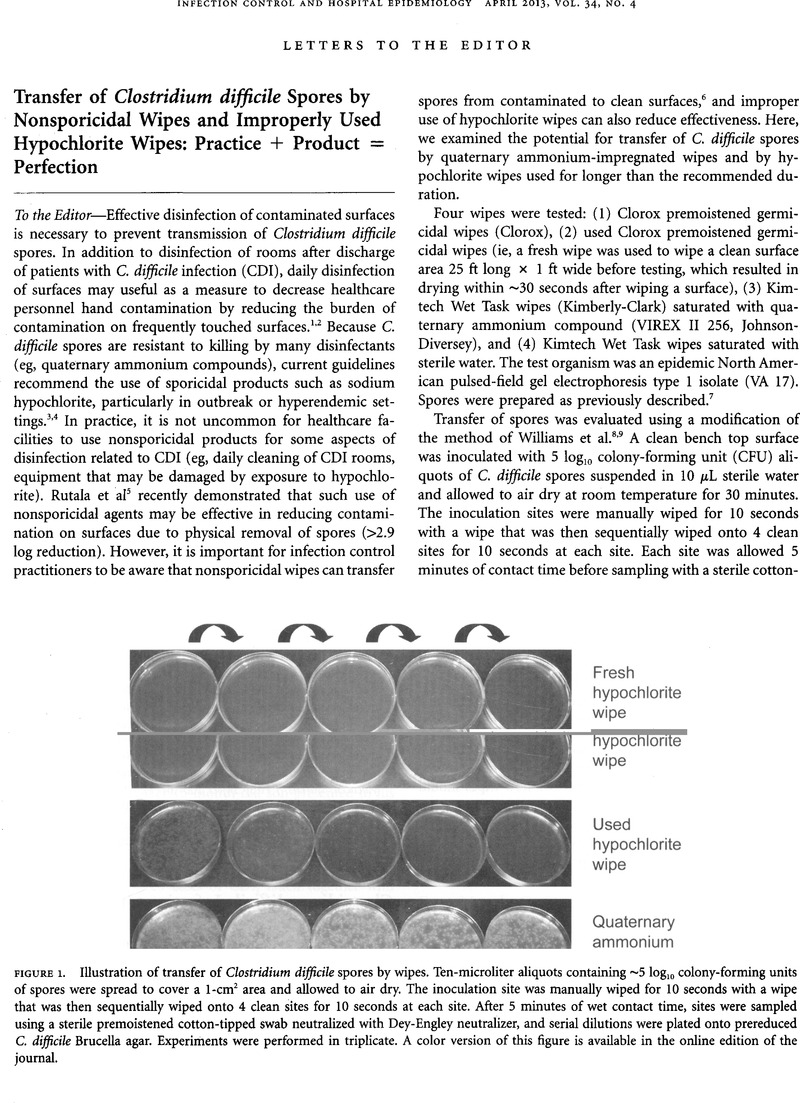Crossref Citations
This article has been cited by the following publications. This list is generated based on data provided by Crossref.
Weber, David J.
Anderson, Deverick
and
Rutala, William A.
2013.
The role of the surface environment in healthcare-associated infections.
Current Opinion in Infectious Diseases,
Vol. 26,
Issue. 4,
p.
338.
Rutala, William A.
and
Weber, David J.
2014.
Selection of the Ideal Disinfectant.
Infection Control & Hospital Epidemiology,
Vol. 35,
Issue. 7,
p.
855.
Meyer, K.M.
Tufts, J.A.
Calfee, M.W.
and
Oudejans, L.
2014.
Efficacy of sporicidal wipes for inactivation of a Bacillus anthracis
surrogate.
Journal of Applied Microbiology,
Vol. 117,
Issue. 6,
p.
1634.
Ramm, Lauren
Siani, Harsha
Wesgate, Rebecca
and
Maillard, Jean-Yves
2015.
Pathogen transfer and high variability in pathogen removal by detergent wipes.
American Journal of Infection Control,
Vol. 43,
Issue. 7,
p.
724.
Rutala, William A.
and
Weber, David J.
2016.
Monitoring and improving the effectiveness of surface cleaning and disinfection.
American Journal of Infection Control,
Vol. 44,
Issue. 5,
p.
e69.
Boyce, John M.
2016.
Modern technologies for improving cleaning and disinfection of environmental surfaces in hospitals.
Antimicrobial Resistance & Infection Control,
Vol. 5,
Issue. 1,
Cadnum, Jennifer L.
Jencson, Annette L.
O’Donnell, Marguerite C.
Flannery, Elizabeth R.
Nerandzic, Michelle M.
and
Donskey, Curtis J.
2017.
An Increase in Healthcare-Associated Clostridium difficile Infection Associated with Use of a Defective Peracetic Acid–Based Surface Disinfectant.
Infection Control & Hospital Epidemiology,
Vol. 38,
Issue. 3,
p.
300.
Schrank, Gregory
and
Branch-Elliman, Westyn
2017.
Breaking the Chain of Infection in Older Adults.
Infectious Disease Clinics of North America,
Vol. 31,
Issue. 4,
p.
649.
Boyce, John M.
Guercia, Kerri A.
Sullivan, Linda
Havill, Nancy L.
Fekieta, Renee
Kozakiewicz, Janet
and
Goffman, David
2017.
Prospective cluster controlled crossover trial to compare the impact of an improved hydrogen peroxide disinfectant and a quaternary ammonium-based disinfectant on surface contamination and health care outcomes.
American Journal of Infection Control,
Vol. 45,
Issue. 9,
p.
1006.
Weber, David J.
and
Rutala, William A.
2017.
Response to letter to the editor regarding “Occupational health risks associated with the use of germicides in health care”.
American Journal of Infection Control,
Vol. 45,
Issue. 1,
p.
97.
Deshpande, Abhishek
and
Donskey, Curtis J.
2017.
Practical Approaches for Assessment of Daily and Post-discharge Room Disinfection in Healthcare Facilities.
Current Infectious Disease Reports,
Vol. 19,
Issue. 9,
Saccucci, Matteo
Bruni, Erika
Uccelletti, Daniela
Bregnocchi, Agnese
Sarto, Maria Sabrina
Bossù, Maurizio
Di Carlo, Gabriele
and
Polimeni, Antonella
2018.
Surface Disinfections: Present and Future.
Journal of Nanomaterials,
Vol. 2018,
Issue. ,
p.
1.
Siani, Harsha
Wesgate, Rebecca
and
Maillard, Jean-Yves
2018.
Impact of antimicrobial wipes compared with hypochlorite solution on environmental surface contamination in a health care setting: A double-crossover study.
American Journal of Infection Control,
Vol. 46,
Issue. 10,
p.
1180.
Mustapha, Aishat
Alhmidi, Heba
Cadnum, Jennifer L.
Jencson, Annette L.
and
Donskey, Curtis J.
2018.
Efficacy of manual cleaning and an ultraviolet C room decontamination device in reducing health care–associated pathogens on hospital floors.
American Journal of Infection Control,
Vol. 46,
Issue. 5,
p.
584.
Ng Wong, Yilen K.
Alhmidi, Heba
Mana, Thriveen S.C.
Cadnum, Jennifer L.
Jencson, Annette L.
and
Donskey, Curtis J.
2019.
Impact of routine use of a spray formulation of bleach on Clostridium difficile spore contamination in non-C difficile infection rooms.
American Journal of Infection Control,
Vol. 47,
Issue. 7,
p.
843.
Rutala, William A.
and
Weber, David J.
2019.
Best practices for disinfection of noncritical environmental surfaces and equipment in health care facilities: A bundle approach.
American Journal of Infection Control,
Vol. 47,
Issue. ,
p.
A96.
Wesgate, R.
Robertson, A.
Barrell, M.
Teska, P.
and
Maillard, J-Y.
2019.
Impact of test protocols and material binding on the efficacy of antimicrobial wipes.
Journal of Hospital Infection,
Vol. 103,
Issue. 1,
p.
e25.
Jencson, Annette L.
Cadnum, Jennifer L.
Wilson, Brigid M.
and
Donskey, Curtis J.
2019.
Spores on wheels: Wheelchairs are a potential vector for dissemination ofpathogens in healthcare facilities.
American Journal of Infection Control,
Vol. 47,
Issue. 4,
p.
459.
Tyan, Kevin
Jin, Katherine
and
Kang, Jason
2019.
A novel color additive for bleach wipes indicates surface coverage and contact time to improve thoroughness of cleaning.
Infection Control & Hospital Epidemiology,
Vol. 40,
Issue. 2,
p.
256.
Song, Xinyu
Vossebein, Lutz
and
Zille, Andrea
2019.
Efficacy of disinfectant-impregnated wipes used for surface disinfection in hospitals: a review.
Antimicrobial Resistance & Infection Control,
Vol. 8,
Issue. 1,





